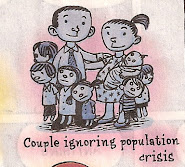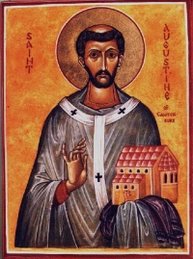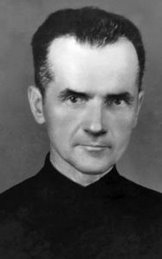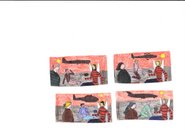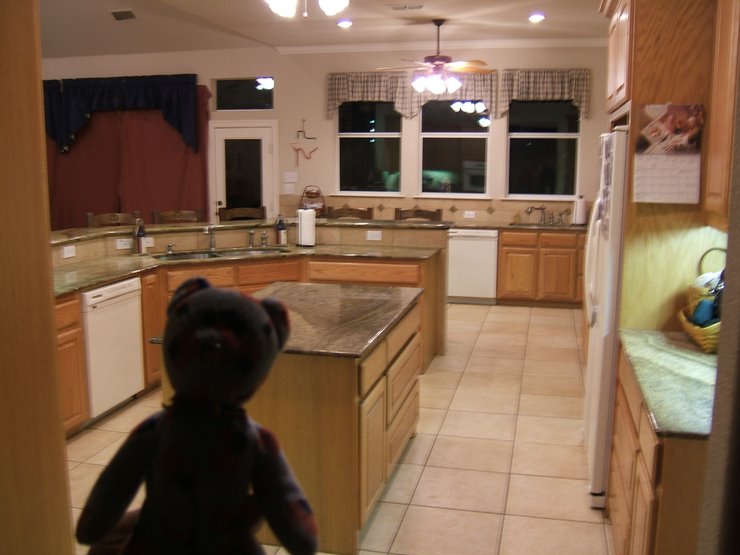Here is a video shown at the Diocese of Dallas Catholic Pro-Life Committee Dinner on Saturday night:
Theodore's Memorial Video
Wednesday, March 30, 2011
Sunday, March 27, 2011
Movie Review: Des Hommes et des Dieux, or Of Gods and Men
Des Hommes et des Dieux
Released in English as Of Gods and Men
Released in May, 2010
"Die Grosse Stille meets To Quell the Terror meets Charles de Foucauld"
I went to see this movie on the Solemnity of St. Joseph because one of my children wanted to see it with some friends. The movie had a limited engagement in Dallas, and we did not want to have him see it without screening it first. So, I found myself sitting in a darkened theatre during Lent quite against my will, and I really enjoyed what I saw.
THIS REVIEW MAY CONTAIN SPOILERS.
Parental guidance: This movie has one graphic violence scene, and various corpses litter the screen at times, but nobody gets naked in this movie. There is one scene where a monk, totally out of character, says the F-bomb to another monk. Other than that inappropriate scene, the movie was excellent.
Des Hommes et des Dieux was released last May, and was released in English as Of Gods and Men - The title comes from Psalm 82, verses 6-7:
"I have said, Ye are gods; and all of you are children of the most High. But ye shall die like men, and fall like one of the princes."
The movie is about the seven monks of the Trappist monastery in Tibhirine, Algeria, who were beheaded in 1996. There is still some question as to who killed the monks, and the movie does not clear up that question. Algeria was torn by a civil war at the time, and the monastery found itself in the middle of the conflict. The monks saw the sick in their infirmary and sold produce in the local market. They got along very well with the local population, which was predominantly Moslem. As the conflict got closer, rebels started to 'visit' them for supplies and medical assistance. This brought the monks under scrutiny as possible rebel sympathizers by the military. They were ordered out of the country by the government of Algeria. The movie examines the monk's reasons to stay in the country despite the increased risk to their lives.
The movie reminded me of Die Grosse Stille because it used the same film techniques, and would sometimes linger on the monks praying, chanting, or performing some mundane task in the monastery. I think this was done to show how the monks kept up with their daily routine, relying on Divine Providence to see them through the conflict.
To Quell the Terror came to mind when one considers that the monks all decided to stay rather than abandon their vocation to pray and work in Algeria. I was struck by the actors who showed how their characters really wrestled with the decision to stay, and how they were still afraid at what might happen. These were real people, not fictitious religious who laughed at the possibility of martyrdom. Near the end of the movie, after celebrating Mass, the monks share their Sunday meal and a bottle of wine while listening to Tchaikovsky's Swan Lake. The emotions displayed by the monks, as they realize that this may be their last meal together, was heart-wrenching. I was reminded of the chocolate which the Mother Superior got for her nuns so they would have the strength to make it to the guillotine.
I was reminded of Blessed Charles de Foucauld because of his dedication to the Muslim people, his failure at converting any of them, and how he ended up being martyred by them. In addition, I am always reminded of the prayer he wrote, and I was given when I was a lot younger than I am now:
My Father,
I abandon myself to you.
Make of me what you will.
Whatever you make of me,
I thank you.
I am ready for everything
I accept everything.
Provided that your will be done in me,
In all your creatures.
I desire nothing else, Lord.
I put my soul into your hands,
I give it to you, Lord,
With all the love in my heart,
Because I love you,
And because it is for me a need of love
To give myself,
To put myself in your hands unreservedly,
With infinite trust.
For You are my Father.
The movie is in French, with English subtitles. The two 'stars' of the movie, Lambert Wilson and Michael Lonsdale, have previously played in English-speaking movies as villains. It was neat to see them speaking their native language, and being good guys this time.
In one scene, the monks are eating their meal in the refectory, and it looks as if the only thing they are eating is 'French Fries.' It made me wonder what they call sliced pieces of potato....
I also wondered about the monks. Most were old men, and it reminded me to pray for more vocations to the priesthood and religious.
Now for a trailer or two:
Released in English as Of Gods and Men
Released in May, 2010
"Die Grosse Stille meets To Quell the Terror meets Charles de Foucauld"
I went to see this movie on the Solemnity of St. Joseph because one of my children wanted to see it with some friends. The movie had a limited engagement in Dallas, and we did not want to have him see it without screening it first. So, I found myself sitting in a darkened theatre during Lent quite against my will, and I really enjoyed what I saw.
THIS REVIEW MAY CONTAIN SPOILERS.
Parental guidance: This movie has one graphic violence scene, and various corpses litter the screen at times, but nobody gets naked in this movie. There is one scene where a monk, totally out of character, says the F-bomb to another monk. Other than that inappropriate scene, the movie was excellent.
Des Hommes et des Dieux was released last May, and was released in English as Of Gods and Men - The title comes from Psalm 82, verses 6-7:
"I have said, Ye are gods; and all of you are children of the most High. But ye shall die like men, and fall like one of the princes."
The movie is about the seven monks of the Trappist monastery in Tibhirine, Algeria, who were beheaded in 1996. There is still some question as to who killed the monks, and the movie does not clear up that question. Algeria was torn by a civil war at the time, and the monastery found itself in the middle of the conflict. The monks saw the sick in their infirmary and sold produce in the local market. They got along very well with the local population, which was predominantly Moslem. As the conflict got closer, rebels started to 'visit' them for supplies and medical assistance. This brought the monks under scrutiny as possible rebel sympathizers by the military. They were ordered out of the country by the government of Algeria. The movie examines the monk's reasons to stay in the country despite the increased risk to their lives.
The movie reminded me of Die Grosse Stille because it used the same film techniques, and would sometimes linger on the monks praying, chanting, or performing some mundane task in the monastery. I think this was done to show how the monks kept up with their daily routine, relying on Divine Providence to see them through the conflict.
To Quell the Terror came to mind when one considers that the monks all decided to stay rather than abandon their vocation to pray and work in Algeria. I was struck by the actors who showed how their characters really wrestled with the decision to stay, and how they were still afraid at what might happen. These were real people, not fictitious religious who laughed at the possibility of martyrdom. Near the end of the movie, after celebrating Mass, the monks share their Sunday meal and a bottle of wine while listening to Tchaikovsky's Swan Lake. The emotions displayed by the monks, as they realize that this may be their last meal together, was heart-wrenching. I was reminded of the chocolate which the Mother Superior got for her nuns so they would have the strength to make it to the guillotine.
I was reminded of Blessed Charles de Foucauld because of his dedication to the Muslim people, his failure at converting any of them, and how he ended up being martyred by them. In addition, I am always reminded of the prayer he wrote, and I was given when I was a lot younger than I am now:
My Father,
I abandon myself to you.
Make of me what you will.
Whatever you make of me,
I thank you.
I am ready for everything
I accept everything.
Provided that your will be done in me,
In all your creatures.
I desire nothing else, Lord.
I put my soul into your hands,
I give it to you, Lord,
With all the love in my heart,
Because I love you,
And because it is for me a need of love
To give myself,
To put myself in your hands unreservedly,
With infinite trust.
For You are my Father.
The movie is in French, with English subtitles. The two 'stars' of the movie, Lambert Wilson and Michael Lonsdale, have previously played in English-speaking movies as villains. It was neat to see them speaking their native language, and being good guys this time.
In one scene, the monks are eating their meal in the refectory, and it looks as if the only thing they are eating is 'French Fries.' It made me wonder what they call sliced pieces of potato....
I also wondered about the monks. Most were old men, and it reminded me to pray for more vocations to the priesthood and religious.
Now for a trailer or two:
What I Wish I’d Known About Raising a Child With Autism

What I Wish I'd Known about Raising a Child with Autism: A Mom and a Psychologist Offer Heartfelt Guidance for the First Five Years
Future Horizons (2011)
Actually, this is a book PREVIEW. This book will be available soon.
Before starting, I must make a few disclaimers. One is that I was asked to preview this book by the author. I was delighted to be asked and am not receiving any type of compensation for this blog entry. Second, although I am a physician, I do not practice any specialty which addresses the diagnosis and management of autism; however, I do have a lot of experience with autistic children. As a pediatric anesthesiologist, I care for autistic children who require anesthesia for surgical, dental, and other procedures. More importantly, as a parent, I was blessed with an autistic child for fifteen years. Carolyn and I were blessed with our third son, Theodore, who passed away in April, 2008. This experience, as Bobbie Sheahan would say, does not make me an expert, but does help when reviewing this book.
In addition, this book represents my views and not those of my employer.
What I Wish I’d Known About Raising a Child With Autism was written by Bobbi Sheahan, a lawyer who is presently a stay at home mom, and Kathy DeOrnellas, Ph.D., a psychologist who treats autistic children. Mrs. Sheahan has a daughter, Grace, with Autism Spectrum Disorder (ASD) who is now seven years old. This book was inspired by the many challenges she faced in searching for a diagnosis as well as a treatment for Grace. This book was written to help those parents who are beginning to notice that one of their children appears to be ‘different‘ and don't know what to do about it. As Bobbi Sheahan says in the preface, “we are here to hold your hand as you walk through a door that you and your child didn’t choose....” Another reason for writing this book was to reassure parents who may feel overwhelmed with the behavior of an autistic child. To finish the sentence quoted above, “...come on in, there are lots of us here waiting for you.”
This book consists of thirteen chapters, and both authors contribute separately to each chapter. Mrs. Sheahan writes mainly from her own experience and research in dealing with Grace, while Dr. DeOrnellas provides her expert opinion to corroborate what Mrs. Sheahan has stated. I really appreciated this; especially when references cited in are listed at the end of each chapter. I don’t like reading things where it appears that data has been ‘pulled out of midair.’
The first three chapters deal with the basics of autism. In chapter one, Mrs. Sheahan relates some of her family background as well as the circumstances of her pregnancy and birth of Grace. She describes how Grace was different from her older sister, how she was quiet and easier to manage as an infant. Chapter two is all by Dr. DeOrnellas, with terminology and statistics discussed, including the cost for the treatment of autism. That was rather sobering. In chapter three, Mrs. Sheahan begins to realize that Grace is different, and talks about the difficulty of coming to grips with having a child who is not considered normal. Finding a professional who could help her was very difficult, and the lessons learned from that effort are discussed in this chapter as well.
Chapter four has a section in it called ‘a completely non-scientific discussion of the origins of autism, with no conclusions reached.’ This is a good description for this chapter. Some of the theories mentioned are very thought-provoking.
After this journey into the theoretical, the fifth chapter delves into the practical - and sometimes unsavory - aspects of parenting an autistic child. Food preferences and abnormalities, such as pica are discussed, as are challenges with maintaining good oral hygiene. The extensive efforts needed to childproof an autistic child’s house reminds me that raising an autistic child involves all members of the household, especially the siblings.
Chapters six, seven, and eight deal with some of the more striking characteristics of autistic children. Communication and social skills, pain tolerance issues, and the need for a routine are all discussed. Here, Mrs. Sheahan makes a recommendation which I think should have come at the start of the book: keep a journal. This is a great idea, for any parent, but especially for parents of children with autism. Chapter eight also contains some great insight into the mind of an autistic child:
“What the books of Temple Grandin and many conversations with Dr. DeOrnellas taught me was that much of Grace’s behavior is motivated by anxiety. I started to write “inexplicable behavior,” but it’s quite explicable; I just need to apply myself to learning my child’s language. She speaks more with actions than in words, and she doesn’t do things just to frustrate or confuse me. She does things for a reason, and if I am respectful of the fact that the reasons are perfectly reasonable to her, I just might learn what that reason is.”
This is still good advice.
Chapters nine, ten and eleven deal with education issues, siblings - especially sibling rivalry issues, friendships, and dealing with the world in general. I had to laugh when Dr. DeOrnellas was discussing animal therapy with autistic children and mentioned a family who had moved from California to North Texas and expected that their child would be able to continue ‘dolphin therapy.’
Chapter twelve is for parents, especially mothers. Mrs. Sheahan makes the point that one parent cannot do this alone; husbands have to be involved in the care of an autistic child. Other means for help are out there as well, but none is as important as the love between and husband and a wife directed toward the care of their children.
There is No Finish Line is the title of the final chapter, which points out that raising an autistic child will probably never end. They may never be able to leave your care. This thought kept going through my mind as I read this book, for the Sheahan family has not gone through that time of life known as adolescence with an autistic child.
In chapter twelve, Mrs. Sheahan mentions one of the greatest blessings of having an autistic child, one which I have seen in our own life:
“One of the major upsides of our situation is that we have the nicest people in our lives because everyone else has fled.”
It’s true. Some people can’t deal with someone else’s autistic child, and those who can are really practicing charity. Mrs. Sheahan gives many examples of people who understand it when Grace does odd things, or when the whole family has to leave a party or other social engagement suddenly. Those people really reflect the face of Christ when they let someone like Grace into their lives.
I liked this book. I liked the organization of it, as it went from Grace’s birth, early development, and growth. Along the way, the various challenges which autism brings to life were discussed, including Dr. DeOrnellas’ input as a professional. This gave credence to Mrs. Sheahan’s observations. I appreciated the references at the end of each chapter, and the bibliography at the end of the book gives many great suggestions for further reading.
One thing that took a while for me to get used to was Mrs. Sheahan’s sense of humor. There were times when I thought it was a bit much for such a serious subject. After reading half of the book, I decided to step back a moment and stop thinking about why I did not care for her humorous remarks, and instead ask myself why she included humor in this book. The answer came, almost instantaneously, that something as daunting as raising an autistic child requires that a parent keep a sense of humor. There are enough tears and heartaches in raising a ‘normal‘ child, let alone one with autism, and humor provides a tremendous consolation.
I would recommend this book without reservation. It serves as a good book for those who are considering that their child may be autistic, or have children newly diagnosed as autistic. This book would be a good beginner book for parents who want to know about autism, and a great source for further reading on the subject.
I have tried (unsuccessfully) to write this review without bringing my own experience as a father of an autistic child into it. Now that the review is over, I will break that vow. While reading this book, I was reminded of so many things which Theodore did, and how hard it was to deal with him at times. But more often, I recall the things he did which gave us a laugh, or great joy. He really loved to make us laugh. With time, the memories of the heartaches fade more than the laughter. For us, the ‘Finish Line‘ was at fifteen with Theodore, which ended suddenly on a Thursday morning in April, 2008. For those of you with autistic children, I want to tell you that there really is only one thing harder than living with the cross of an autistic child: living without him.
Stephen M. Donahue, M.D.
March, 2011
Monday, March 14, 2011
Tuesday, March 08, 2011
Thursday, March 03, 2011
The Return of St. Albert the Great

Back in 1998 I put together a science class for some of the homeschooling boys. I called it the St. Albert the Great Science Club, under the patronage of St. Albert, patron saint of scientists. I would have a class every month, on a Saturday, and I only did it that year. It was a big success, and Carolyn had been after me for a while to start it up with a younger generation of our children.
I said I would work on it. I looked over some notes, and thought about it. Someday I would get around to starting it.
That someday was today. I was off work early, and Carolyn told the kids and I that we could hold our first class that day. I gulped real hard and said I would be ready. Then I headed off to the store to get the materials, the missing ingredient, for our first experiment. When I got back from the store, some Mexican hot chocolate was waiting for me - a gift from some friends of ours in San Antonio. Like most Mexican treats, it was heavy on the sugar. After one cup of lactose-free Abuelita cocoa, I was ready to take on the world.

Briefly I discussed the reason for the class, starting with a definition of science, and then discussing the reasons for the study of science. I discovered a great reference for this subject; namely, the 'why study science' in the context of our Catholic Faith. I found this in a book called For the Beauty of the Earth, by Klassen et. al. and published by St. Paul's Publishing Company (1983). I was surprised to see it dedicated to John Senior, Dennis Quinn, and Frank Nelick; these were the founders of the Integrated Humanities Program at the University of Kansas in the early 1970's. This program resulted in a lot of students converting to the Faith; some of them felt a calling to the consecrated life. A few of those called to the religious life joined the Benedictine monastery at Fontgombault in France, and then returned to the United States to establish the Benedictine Monastery at Clear Creek. It is amazing to see the fruits of the work of these three men almost forty years after.
I am still working my way slowly through John Senior's book, The Death of Christian Culture.
Here is the list for why we study science, broken down into what are considered the 'ends,' or reasons for studying science. I found these listed in some other Catholic science books - in more child friendly terms - but I like this list for my own benefit:
 After discussing the 'why,' we discussed the scientific method, and the various parts of it. It was a lively discussion, with my students ranging in age from 5 to 14 years old. Briefly, the scientific method consists of 1. asking a question, 2. forming an explanation, or hypothesis, 3. construct a test, or experiment, to prove your explanation, 4. perform the experiment, recording the results, and 5. draw some conclusion based on the results.
After discussing the 'why,' we discussed the scientific method, and the various parts of it. It was a lively discussion, with my students ranging in age from 5 to 14 years old. Briefly, the scientific method consists of 1. asking a question, 2. forming an explanation, or hypothesis, 3. construct a test, or experiment, to prove your explanation, 4. perform the experiment, recording the results, and 5. draw some conclusion based on the results.We did the first experiment I did back in 1998: the popcorn test. The question was to determine if increasing the water content of popcorn would make it pop better, with fewer 'old maids' left in the bottom of the bowl. Here is what it looked like on the chalk board:

We had three batches of popcorn: popcorn warmed in the oven, popcorn soaked in water, and a 'control' group of popcorn which was left alone. I originally planned for the soaking/drying time to be only 30 minutes, but our discussion went a bit longer than that.

You can imagine what happened. Carolyn wisely had us pop the 'control' group first, and that showed us how long to pop the other batches.
The 'dry' popcorn came out of the oven looking like this:
 This is what it looked like after 45 seconds on the stove top. The video does not include the mad dash to get the burning popcorn out of the house:
This is what it looked like after 45 seconds on the stove top. The video does not include the mad dash to get the burning popcorn out of the house:The soaked popcorn did not fare much better. In the picture below, our students are standing behind the different batches of popcorn. The 'control' group is on the left, the 'soaked' group in the middle, and the charcoal or 'dry' group is on the right.
 After the experiment was over, and the air had cleared in the kitchen, we sat around and came to some conclusions. I think the children did very well, but the best conclusion has to be the third one listed on the chalkboard below:
After the experiment was over, and the air had cleared in the kitchen, we sat around and came to some conclusions. I think the children did very well, but the best conclusion has to be the third one listed on the chalkboard below: Butter and salt.
Butter and salt.
Tuesday, March 01, 2011
60,000 - Plus
Subscribe to:
Comments (Atom)
Our Lady of the Mysterious Decapitation

Now restored with the help of some cement!
Prayer to Our Lady of the Mysterious Decapitation
Mary my mother, take my hand today, and all days.
Lead me away from all occasions of sin.
Guide me in fulfilling your last words in the Gospel,
"Do whatever He tells you."
Amen.
Lead me away from all occasions of sin.
Guide me in fulfilling your last words in the Gospel,
"Do whatever He tells you."
Amen.











